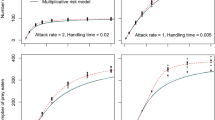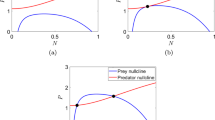Abstract
Whereas impacts of predator interference on predator-prey dynamics have received considerable attention, the “inverse” process—foraging facilitation among predators—have not been explored yet. Here we show, via mathematical models, that impacts of foraging facilitation on predator-prey dynamics depend on the way this process is modeled. In particular, foraging facilitation destabilizes predator-prey dynamics when it affects the encounter rate between predators and prey. By contrast, it might have a stabilizing effect if the predator handling time of prey is affected. Foraging facilitation is an Allee effect mechanism among predators and we show that for many parameters, it gives rise to a demographic Allee effect or a critical predator density in need to be crossed for predators to persist. We explore also the effects of predator interference, to make the picture “symmetric” and complete. Predator interference is shown to stabilize predator-prey dynamics once its strength is not too high, and thus corroborates results of others. On the other hand, there is a wide range of model parameters for which predator interference gives rise to three co-occurring co-existence equilibria. Such a multi-equilibrial regime is rather robust as we observe it for all the functional response types we explore. This is a previously unreported phenomenon which we show cannot occur for the Beddington–DeAngelis functional response. An interesting topic for future research thus might be to seek for general conditions on predator functional responses that would produce multiple co-existence equilibria in a predator-prey model.
Similar content being viewed by others
References
Abrams, P.A., 1994. The fallacies of “ratio-dependent” predation. Ecology 75, 1842–1850.
Abrams, P.A., Ginzburg, L.R., 2000. The nature of predation: prey dependent, ratio dependent or neither? Trends Ecol. Evol. 15, 337–341.
Arnqvist, G., Jones, T.M., Elgar, M.A., 2006. Sex-role reversed nuptial feeding reduces male kleptoparasitism of females in Zeus bugs (Heteroptera: Veliidae). Biol. Lett. 2, 491–493.
Beddington, J.R., 1975. Mutual interference between parasites or predators and its effect on searching efficiency. J. Animal Ecol. 44, 331–340.
Bednarz, J.C., 1988. Cooperative hunting in Harris’ hawks (Parabuteo unicinctus). Science 239, 1525–1527.
Begon, M., Harper, J.L., Townsend, C.R., 1990. Ecology: Individuals, Populations and Communities (2nd edn.). Blackwell Scientific, Oxford.
Berryman, A.A., 1992. The origins and evolution of predator-prey theory. Ecology 73, 1530–1535.
Berryman, A.A., Dennis, B., Raffa, K.F., Stenseth, N.C., 1985. Evolution of optimal group attack, with particular reference to bark beetles (Coleoptera: Scolytidae). Ecology 66, 898–903.
Boesch, C., 1994. Cooperative hunting in wild chimpanzees. Animal Behav. 48, 653–667.
Briggs, C.J., Hoopes, M.F., 2004. Stabilizing effects in spatial parasitoid-host and predator-prey models: a review. Theor. Popul. Biol. 65, 299–315.
Clayton, D.A., 1978. Socially facilitated behavior. Q. Rev. Biol. 53, 373–392.
Cosner, C., DeAngelis, D., Ault, J.S., Olson, D.B., 1999. Effects of spatial grouping on the functional response of predators. Theor. Popul. Biol. 56, 65–75.
Courchamp, F., Macdonald, D.W., 2001. Crucial importance of pack size in the African wild dog Lycaon pictus. Animal Conserv. 4, 169–174.
Courchamp, F., Berec, L., Gascoigne, J., 2008. Allee Effects in Ecology and Conservation. Oxford University Press, Oxford.
Crowley, P.H., 1981. Dispersal and the stability of predator-prey interactions. Am. Natur. 118, 673–701.
Dawson, J.W., Mannan, R.W., 1991. The role of territoriality in the social organization of Harris’ hawks. The Auk 108, 661–672.
de Roos, A.M., McCauley, E., Wilson, W.G., 1991. Mobility versus density-limited predator-prey dynamics on different spatial scales. Proc. R. Soc. Lond. B 246, 117–122.
DeAngelis, D.L., Goldstein, R.A., O’Neill, R.V., 1975. A model for trophic interaction. Ecology 56, 881–892.
Denno, R.F., Benrey, B., 1997. Aggregation facilitates larval growth in the neotropical nymphalid butterfly Chlosyne janais. Ecol. Entomol. 22, 133–141.
Dhooge, A., Govaerts, W., Kuznetsov, Y.A., 2003. Matcont: a Matlab package for numerical bifurcation analysis of ODEs. ACM Trans. Math. Softw. 29, 141–164.
Gardner, J.L., 2004. Winter flocking behaviour of speckled warblers and the Allee effect. Biol. Conserv. 118, 195–204.
Gascoigne, J.C., Lipcius, R.N., 2004. Allee effects driven by predation. J. Appl. Ecol. 41, 801–810.
Grünbaum, D., Veit, R.R., 2003. Black-browed albatrosses foraging on Antarctic krill: density-dependence through local enhancement? Ecology 84, 3265–3275.
Hassell, M.P., Lawton, J.H., Beddington, J.R., 1976. The components of arthropod predation. 1. The prey death rate. J. Animal Ecol. 45, 135–164.
Huffaker, C.B., 1958. Experimental studies on predation: dispersion factors and predator-prey oscillations. Hilgardia 27, 343–383.
Huisman, G., DeBoer, R.J., 1997. A formal derivation of the “Beddington” functional response. J. Theor. Biol. 185, 389–400.
Jeschke, J.M., Kopp, M., Tollrian, R., 2002. Predator functional responses: discriminating between handling and digesting prey. Ecol. Monogr. 72, 95–112.
Jost, C., 1998. Comparing predator-prey models qualitatively and quantitatively with ecological time-series data. Dissertation, Institut National Agronomique, Paris-Grignon, France.
Jost, C., Arino, O., Arditi, R., 1999. About deterministic extinction in ratio-dependent predator-prey models. Bull. Math. Biol. 61, 19–32.
Kenward, R.E., 1978. Hawks and doves: factors affecting success and selection in goshawk attacks on woodpigeons. J. Animal Ecol. 47, 449–460.
Kim, K.W., Krafft, B., Choe, J.C., 2005a. Cooperative prey capture by young subsocial spiders. I. Functional value. Behav. Ecol. Sociobiol. 59, 92–100.
Kim, K.W., Krafft, B., Choe, J.C., 2005b. Cooperative prey capture by young subsocial spiders. II. Behavioral mechanism. Behav. Ecol. Sociobiol. 59, 101–107.
Krause, J., Ruxton, G.D., 2002. Living in Groups. Oxford University Press, Oxford.
Krebs, C.J., 2001. Ecology (5th edn.). Benjamin Cummings, San Francisco.
Křivan, V., 2007. The Lotka–Volterra predator-prey model with foraging-predation risk trade-offs. Am. Natur. 170, 771–782.
Kuang, Y., Beretta, E., 1998. Global qualitative analysis of a ratio-dependent predator-prey system. J. Math. Biol. 36, 389–406.
Marsh, A.C., Ribbink, A.J., 1986. Feeding schools among Lake Malawi cichlid fishes. Environ. Biol. Fishes 15, 75–79.
Mchich, R., Auger, P., Poggiale, J.-C., 2007. Effect of predator density dependent dispersal of prey on stability of a predator-prey system. Math. Biosci. 206, 343–356.
Murdoch, W.W., Oaten, A., 1975. Predation and population stability. In: Macfadyen, A. (Ed.), Advances in Ecological Research, pp. 1–131. Academic Press, New York.
Packer, C., Ruttan, L., 1988. The evolution of cooperative hunting. Am. Natur. 132, 159–198.
Partridge, B.L., Johansson, J., Kalish, J., 1983. The structure of schools of giant bluefin tuna in Cape Cod Bay. Environ. Biol. Fishes 9, 253–262.
Rogers, D.J., Hassell, M.P., 1974. General models for insect parasite and predator searching behaviour: interference. J. Animal Ecol. 43, 239–253.
Rosenzweig, M.L., 1971. Paradox of enrichment: destabilization of exploitation ecosystems in ecological time. Science 171, 385–387.
Ruxton, G.D., 1995. Short term refuge use and stability of predator-prey models. Theor. Popul. Biol. 47, 1–17.
Ruxton, G.D., Gurney, W.S.C., de Roos, A.M., 1992. Interference and generation cycles. Theor. Popul. Biol. 42, 235–253.
Skalski, G.T., Gilliam, J.F., 2001. Functional responses with predator interference: viable alternatives to the Holling type II model. Ecology 82, 3083–3092.
Solomon, M.E., 1949. The natural control of animal populations. J. Animal Ecol. 18, 1–35.
Spradbery, J.P., 1970. Host finding by Rhyssa persuasoria (L.), an ichneumonid parasite of siricid woodwasps. Animal Behav. 18, 103–114.
Wilson, W.G., de Roos, A.M., McCauley, E., 1993. Spatial instabilities within the diffusive Lotka–Volterra system: individual-based simulation results. Theor. Popul. Biol. 43, 91–127.
Xiao, D., Ruan, S., 2001. Global dynamics of a ratio-dependent predator-prey system. J. Math. Biol. 43, 268–290.
Zhou, S.-R., Liu, Y.-F., Wang, G., 2005. The stability of predator-prey systems subject to the Allee effects. Theor. Popul. Biol. 67, 23–31.
Author information
Authors and Affiliations
Corresponding author
Rights and permissions
About this article
Cite this article
Berec, L. Impacts of Foraging Facilitation Among Predators on Predator-prey Dynamics. Bull. Math. Biol. 72, 94–121 (2010). https://doi.org/10.1007/s11538-009-9439-1
Received:
Accepted:
Published:
Issue Date:
DOI: https://doi.org/10.1007/s11538-009-9439-1




